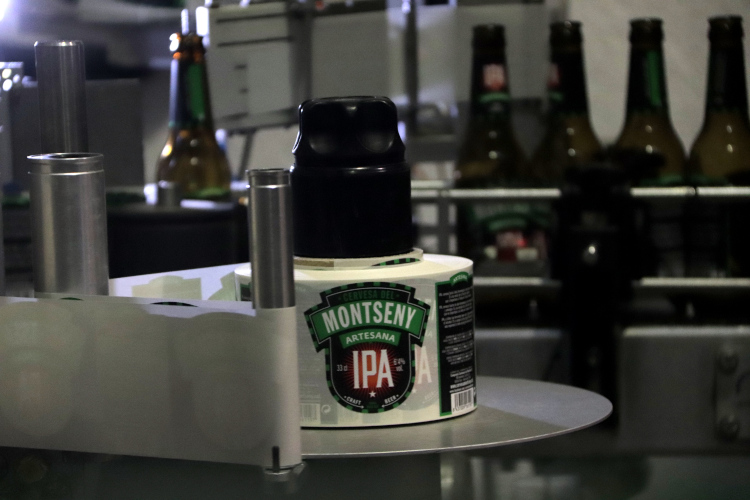The brewery that uses chestnuts to make beer
Nestled in the middle of a vast mountainous area, Cervesa del Montseny is one of the biggest success stories of craft beer in Catalonia

Montseny is a vast natural park and mountainous area in the heart of Catalonia, famous for its chestnuts, fir trees, its own species of salamander (Tritó del Montseny), isolated churches and chapels, the wood and cork extracted by humans since ancient times… and since 2007, its own craft brewery.
Cervesa del Montseny is probably the first brand that comes to a lot of Catalans' minds when asked about a craft beer – but surprisingly, the company is only 14 years old.
Catalonia boasts over 100 artisanal beer producers spread out across the country, and Cervesa del Montseny is the top seller for locals, but acknowledge that others surpass them in international sales.
From Sant Miquel de Balenyà, just outside Vic, their brews are served in bars and specialized stores, but also in supermarkets, which makes them stand out. "We have around 10 employees and our turnover is around €1.2 million,” Jordi Llebaria explained to Catalan News. “Despite having a lot of visibility and being in supermarkets, we are still a small company," he adds.
Listen to our podcast below:
Entering the main building of this brewery – and probably of many others – is already a unique experience. The smell of ingredients being processed and the wood of some of their equipment to ferment a small part of the production can strike anyone.
A taproom is what first welcomes visitors asthey enter the front door, with six different taps tempting beer-lovers with experience unique flavors.
One side business Cervesa del Montseny has developed is organizing tours for anyone interested, with around 50 people taking up the offer each week. The taproom is not only a greeting space them, but also hosts plenty of cultural events, such as book launches, concerts, screenings, and festivals.
One of the aims is to promote craft beer culture and grow the sense of community, perhaps the main characteristic shaping this industry, along with the passion of those involved.
"The most important thing in the craft beer industry is not numbers, although they are somewhat important of course, but rather being able to make a product with character, well made, with the best ingredients," says Llebaria.
Moving into the factory itself, several stainless steel 3,000-liter tanks and a few slightly smaller ones are where the magic happens: the fermentation process, turning sugar and yeast, along with other raw materials, into beer.
The ‘brewhouse’, the machine where the brewing process begins, and the ‘bright tank’ where it finishes, are the other containers used in the making of 350,000 liters per year at this brewery.
In 2007, some beer lovers with some experience of home brewing and just a little bit of training in the UK came together and decided to set up a business. They had a slice of good fortune in being able to acquire second-hand machinery to get started at a good value.
"During the first years, we had issues of all kinds, above all we had a lack of knowledge. We are passionate for beer, but with far less knowledge than now," Llebaria tells us, admitting that after some years in the business, they always find a friend or resource to ask advice.
Also, the fact that "craft beer had never been done before in Catalonia" was also a major challenge, so these entrepreneurs decided to be very educational at the beginning.
Yet, now, fast-forwarding over a decade, Cervesa del Montseny is flourishing: they make around 15 different kinds of beer, some with low fermentation, such as a German Pils, but mostly with a high level of fermentation, including an IPA, a double IPA, a Blond Ale, a Christmas Ale, a Saison Cuvée, a Session IPA, and… a brown ale with chestnuts from Montseny. "It is a very local product, very typical from the Montseny mountains," Llebaria proudly explains.
This is one of the main virtues of this industry: finding a unique beer on every corner, keen on using local ingredients and full of creativity and experimentation.
The product not only goes through all the various tanks in the brewery but it is then funnelled through pipelines connecting the main production building with another one where everything is bottled and packaged.
A factory line makes sure the beer is sealed into bottles labeled with each of the specialities. Then, bottles are collected into boxes, which pile up, and pile up, and pile up… to the extent that on a normal day around 80,000 bottles of beer can be found in the warehouse adjacent to the bottling area.
Cervesa del Montseny is just one of the over 100 breweries in Catalonia, which, as Jordi Llebaria puts it, "unite a lot of different people who find common ground in beer, which is a very democratic product."